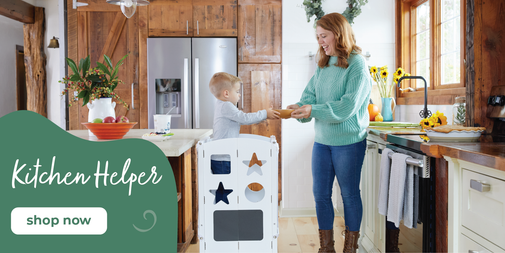Learning in the Kitchen – 9 Skills Toddlers Learn When Using a Guidecraft Kitchen Helper Toddler Tower
Kitchens are ideal environments for nurturing a child’s early development and love for learning. They are hands-on classrooms in a real-life setting where children can observe adults at work, engage their senses, develop motor skills and hand-eye coordination, and apply language and math skills.
A sturdy step stool, like the Kitchen Helper Toddler Tower, offers a safe and secure space within the kitchen in which children can learn. Here are a few ways that spending time in the kitchen can help a child flourish, while fostering a child’s connection to the food that goes into their bodies.

Build Confidence
Concentration Skills
Multi-Sensory Learning
Kitchens are a unique space in the home where children may explore all five senses at the same time. Touching, tasting, smelling, seeing and hearing foods are so helpful for sensory development and fulfill a child’s need for hands-on learning. Utensils and appliances are part of a kitchen’s sensory landscape, as well, whether it’s the scrape of a whisk against a metal bowl or the landing tap of a knife while slicing bananas.
Cooking with your child is also a wonderful way to encourage more adventurous eating. Children are naturally curious about new foods and are more likely to taste a new food on their own when they are consistently exposed to the food without immediate pressure to eat it.
Physical Development
Language Development

Cooking with children provides an opportunity to enrich their vocabulary and demonstrate how we use language to describe our actions and thoughts. Explain what you are doing as you cook and use open-ended questions to ask children what they are doing. Name each ingredient. Use adjectives to describe how things taste or smell. Identify the different parts of foods and utensils, like the tine of a fork or a floret of broccoli. Use words like “first,” “then” and “finally” to introduce sequential language.
Cooking vocabulary is rich with unique words that a child will delight in, as well as practical language that children can use beyond the kitchen.
Math Skills
Cooking is a prime opportunity for children to learn or apply mathematical concepts in a concrete way. Count out loud together as you measure teaspoons or crack eggs. Use subtraction when calculating how much time is left for baking cookies. Introduce fractions when slicing pizza. Demonstrate the concept of greater and less than when measuring ingredients, or how to think spatially when rotating a cookie cutter to fit one more shape into the dough. There are so many organic — and fun — ways to integrate math into cooking and baking.
Science Skills
Since cooking is essentially a science, the kitchen is also a lab in which children can learn scientific concepts through real-life practice. A child may observe changes in consistency and color as ingredients are added to a mixture, or that baked goods rise when heated up in the oven. Encourage your child to pay attention to the different properties of foods. Showing your child how to observe in the kitchen will ignite their curiosity and help teach scientific concepts in a tangible way.
Self-Regulation
Though it may seem counterintuitive to some adults, inviting children up to the counter and granting full access to ingredients that are typically “off limits” will offer them an opportunity to learn self-regulation. Rather than keeping sugar, butter or chocolate chips out of a child’s reach, talk to your child about self-control.
Point out examples of when you have shown self-control and explain why it was a good choice. Children can only learn to self-regulate if presented with opportunities to practice it in the first place.
Personal Responsibility
Asking children to help clean messes in the kitchen will foster their sense of personal responsibility. Show how you gather food scraps and where to deposit them. Demonstrate how to sweep crumbs off the counter and wipe down counters with a sponge. Young children often do not see cleaning as a chore, but rather as an exciting challenge with a clear and achievable goal.
To learn more about the Guidecraft Kitchen Helper Toddler Tower, click here.





















